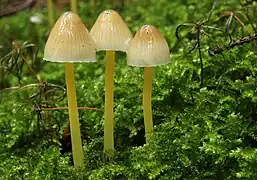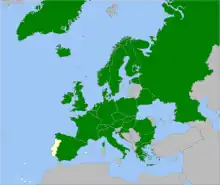| Mycena epipterygia | |
|---|---|
 | |
| Scientific classification | |
| Domain: | Eukaryota |
| Kingdom: | Fungi |
| Division: | Basidiomycota |
| Class: | Agaricomycetes |
| Order: | Agaricales |
| Family: | Mycenaceae |
| Genus: | Mycena |
| Species: | M. epipterygia |
| Binomial name | |
| Mycena epipterygia (Scop.) Gray | |
 | |
| Countries in which M. epipterygia is present (green) | |
| Mycena epipterygia | |
|---|---|
| Gills on hymenium | |
| Hymenium is adnate | |
| Stipe is bare | |
| Spore print is white | |
| Ecology is saprotrophic | |
| Edibility is not recommended | |
Mycena epipterygia is a species of fungus in the family Mycenaceae of mushrooms commonly found in Europe.[1] It is commonly known as yellowleg bonnet[2] or yellow-stemmed mycena.[3] The species is saprotrophic and its appearance is quite variable. For example, a number of members of the genus Mycena, some parts of the fungus are bioluminescent, including in this species, the mycelium.[4] Mycena nivicola has been suggested as a separate species name for the Western variety.[5]
Distribution and habitat
M. epipterygia is a common species in Western Europe (amongst others Netherlands and Belgium). It grows in diverse habitats: in deciduous and coniferous woods, but it is also found in heather and acid grasslands, amongst grasses and mosses. This species grows on the ground. In Britain, the fruiting bodies appear from August to November.[2] In the North American Pacific Northwest, the species appears in groups, in needle litter and on wood.[5]
Description
The cap is striate, bell-shaped at first, but becoming convex, or occasionally nearly flat with the margin turning up slightly. The cap has a sticky surface from which the cuticle can be peeled,[1] and measures 1 to 2 cm (3⁄8 to 3⁄4 in) wide, with a colour varying from yellowish brown to gray-brown.[5] The margin is somewhat irregular, and the flesh white and fragile. The stipe is long and slender, about 4–9 cm (1+5⁄8–3+1⁄2 in) tall and 1–2 mm wide;[6] it does not taper, and is yellowish to yellow-green, the colour serving to distinguish the fungus from other species.[2]
The gills are white to cream, sometimes tinged with pink when older; they are fairly widely spaced, adnate, or slightly decurrent. The spores are amyloidic and have a length of 8 to 10 micrometres and a width of 4 to 5.5 micrometres. The spore print is white to very pale buff.[2]
Edibility
The species is considered edible, but is of little interest in the kitchen.[7]
Similar species
The species resembles Mycena aurantiidisca, M. clavicularis, M. leptocephala, and Roridomyces roridus.[6]
See also
References
- 1 2 Gerhardt, Ewald (2006). De grote paddenstoelengids voor onderweg, Tirion uitgevers B.V., Baarn, ISBN 90-5210-653-3
- 1 2 3 4 "Mycena epipterygia (Scop.) Gray - Yellowleg Bonnet". First Nature. Retrieved 15 January 2021.
- ↑ Thiers, Harry D.; Arora, David (September 1980). "Mushrooms Demystified". Mycologia. 72 (5): 1054. doi:10.2307/3759750. ISSN 0027-5514.
- ↑ Perry, Brian (2007). "Bioluminescent fungi". MycoWeb. Retrieved 15 January 2021.
- 1 2 3 Trudell, Steve; Ammirati, Joe (2009). Mushrooms of the Pacific Northwest. Timber Press Field Guides. Portland, OR: Timber Press. pp. 125–126. ISBN 978-0-88192-935-5.
- 1 2 Davis, R. Michael; Sommer, Robert; Menge, John A. (2012). Field Guide to Mushrooms of Western North America. Berkeley: University of California Press. pp. 175–176. ISBN 978-0-520-95360-4. OCLC 797915861.
- ↑ Phillips, Roger (2010) [2005]. Mushrooms and Other Fungi of North America. Buffalo, NY: Firefly Books. p. 99. ISBN 978-1-55407-651-2.
External links
 Media related to Mycena epipterygia at Wikimedia Commons
Media related to Mycena epipterygia at Wikimedia Commons